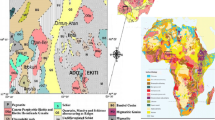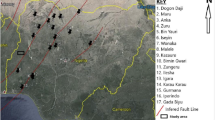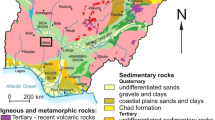Abstract
Geological lineaments, depths to the basement, uranium concentrations, and remobilization in parts of the Upper Benue Trough, covering about 55 × 55 km2 (longitudes 11°30′–12°00′E and 10°30′–10°30′N), Northeastern Nigeria were investigated using integrated High-Resolution Aeromagnetic Data (HRAD) and radiometric data. This was with a view to identifying the potential zones of uranium occurrence in the area. The HRAD was processed to accentuate anomalies of interest and depths estimate of 150–1941 m were obtained from source parameter imaging technique. The results from the superposition of the horizontal gradient magnitude, analytical signal amplitude, first vertical derivative, and 3D Euler solutions of the HRAD revealed that the study area was dissected by linear structures that trend ENE–WSW, NE–SW, E–W, NNE–SSW, WNW–ESE, and NW–SE; among which the ENE–WSW and NE–SW trends dominated. Analyses of radiometric data showed that uranium ores in the study area were possibly remobilized epigenetically from the granitic rocks, and were later deposited into sedimentary rocks (Bima formation). Burashika group (Bongna hills) and Wawa area of the study area showed vein-type deposits, while the anatectic migmatite in the northeastern region and the uranium rich Bima formation showed both fault/fracture and contact types of deposition. It was also observed the northwesterly and southeasterly, dominant dip direction, dipping faults dip in the same direction as the paleocurrent direction (direction of depositions of sediments), and trend in a direction perpendicular to the hypothetical direction of uranium deposition. The study concluded that the studied area is dissected by several linear structures and the studied area possibly contains deposits of uranium ore, which are likely to be found in: the Bima Sandstones of Wade, Shinga, Bima hill, Wuyo, Teli, Bryel, Dali, Barkan, Gasi, Kunkun, Boragara, Deba, and Gberundi localities; the anatectic migmatite at Kubuku, Whada, and Hyama; and the Bongna hills and agglomerates around Burashika, Kawaba, and Galu.



















Similar content being viewed by others
References
Anudu GK, Stephenson RA, Macdonald DM (2014) Using high resolution aeromagnetic data to recognise and map intra-sedimentary volcanic rocks and geological structures across the Cretaceous middle Benue Trough, Nigeria. Elsevier J Afr Earth Sci 99:625–636
Bell RT (1996) Sandstone uranium. Geology Survey of Canada, Geology of Canada, no 8, pp 212–219
Benkhelil J (1986) Geological map of part of the Upper Benue Valley; Explanatory Note. Elf Nigeria Ltd, p 4–16
Bowden P, Bennett JN, Kinnaird JA, Whitley JE, Abaa SI, Hadzigeorgiou-Stavrakis PK (1981) Uranium in the Niger-Nigeria younger granite province. Mineral Mag 44:379–389
Cambon AH (1994) Uranium deposits in granitic rocks. In: Notes on the national training course on uranium geology and exploration. IAEA and NMA, Cairo, Egypt, pp 8–20
Carter JD, Barber DFM, Tait EA (1963) The geology of parts of Adamawa, Bauchi and Bornu Provinces in Northeastern Nigeria. Bulletin of Geological Survey, Niamey, p 30
Clark SP, Peterman ZE, Heier KS (1966) Abundance of uranium, thorium and potassium. In Clarke SP Jr. (Ed), Handbook of physical constants, Geological Society of America. Memoir 97, Section 24, p 521–554
Darnley AG (1975) Geophysics in uranium exploration. Geological Survey of Canada, Uranium Exploration, Ottawa, pp 21–31
Dentith M (2011) Magnetic methods, airborne. In: Gupta HS (ed) Encyclopedia of solid earth geophysics, vol 1. Springer, Dordrecht, pp 761–766
Dobrin MB, Savit CH (1988) Introduction to geophysical prospecting, 4th edn. McGraw-Hill Books, New York, pp 633–725
Foote RS, Humphrey NB (1976) Airborne radiometric techniques and applications to Uranium exploration, Exploration for Uranium Ore (1AEA-SM 208/47). IAEA, Vienna
Funtua II, Okujeni CD (1996) Element distribution patterns in the uranium occurrence at Mika, northeastern Nigeria. Chem Erde 56:245–260
Gaafar I, Aboelkhair H (2014) Analysis of geological and geophysical datasets for radioelement exploration in KabAmiri area, central eastern desert. Egypt. Open Geol J 8(Suppl 1: M3):34–53
Guiraud M (1990) Tectono-sedimentary framework of the early Cretaceous continental Bima Formation (Upper Benue Trough, Northeastern Nigeria). J Afr Earth Sci 10:341–353
Haruna IV, Ahmed HA, Ahmed AS (2012) Geology and tectonosedimentary disposition of the Bima sandstone of the Upper Benue Trough (Nigeria): implications for sandstone-hosted Uranium deposits. J Geol Mining Res 4(7):168–173
Lauri LS, Turunen P (2015) Airborne radiometric data as a uranium exploration tool case studies from Southern Lapland. Geophysical Signatures of Mineral Deposit types in Finland, Geological Survey of Finland, Special Paper 58, pp 107–116
Maurin JC, Lancelot JR (1990) Structural setting and U-Pb dating of uranium mineralization from the north-eastern part of Nigeria (Upper Benue Region). J Afr Earth Sci 10:421–433
Nabighian MN (1972) The analytic signal of two dimensional magnetic bodies with polygonal crosssection: its properties and use for automated anomaly interpretation. Geophysics 37
Nabighian MN (1984) Toward a three-dimensional automatic interpretation of potential field data via generalised Hilbert transforms: fundamental relations. Geophysics 49:780–789
Ndougsa-Mbarga T, Feumoe ANS, Manguelle-Dicoum E, Fairhead JD (2012) Aeromagnetic data interpretation to locate buried faults in South East Cameroon. Geophysica 48(1–2):49–63
Nwajide CS (2013) Geology of Nigeria’s sedimentary basins. CSS Bookshop Limited, First Published, ISBN 978-978-8401-67-4, pp 27–110
Nwosu OB (2014) Determination of magnetic basement depth over parts of middle Benue Trough by Source Parameter Imaging (SPI) technique using HRAM. Int J Sci Technol Res 3(1):262–271
Obaje NG (2009) Geology and mineral resources of Nigeria. Springer, Berlin, pp 2, 49–65
Obiora SC (2009) Field measurements in descriptions of igneous and metamorphic rocks. In: Lambert-Aikhionbare DO, Olayinka AI (eds) Proceedings of field mapping standardisation workshop, Ibadan University Press, Ibadan, pp 105–125
Odebode MO (2010) A handout on the Geology of the Benue and Anambra Basin, Nigeria (unpublished work)
Oshin IO, Rahaman MA (1986) Uranium favourability study in Nigeria. J Afr Earth Sci 5(2):167–175
Philips JD (2000) Locating magnetic contacts: a comparison of the horizontal gradient, analytic signal, and local wavenumber methods: Calgary. In: 70th Meeting, society of exploration geophysicists, expanded abstracts with biographies, 2000 Technical Program, vol 1, pp 402–405
Reid AB, Allsop JM, Granser H, Millet AJ, Somerton IW (1990) Magnetic interpretation in three dimensions using Euler deconvolution. Geophysics 55:80–91
Roest W, Verhoef J, Pilkington M (1992) Magnetic interpretation using 3-D analytical signal. Geophysics 57:116–125
Ruzicka V (1975) New sources of uranium? Types of uranium deposits presently unknown in Canada. Geological Survey of Canada, Uranium Exploration 75, pp 13–47
Ruzicka V (1992) Types of uranium deposits in the former U.S.S.R.; Colorado School of Mines Quarterly Review 92(1):19–27
Sambo AS (2008) Matching electricity supply with demand in Nigeria. In: Paper presented at the “National Workshop on the Participation of State Governments in the Power Sector: Matching Supply with Demand”, 29 July 2008, LadiKwali Hall, Sherato Hotel and Towers, Abuja
Saunders DF, Potts MJ (1976) Interpretation and application of high sensitivity airborne gamma ray spectrometer data; in Exploration for Uranium Ore Deposits. Proc. Series, IAEA, Vienna, pp 107–125
Suh CE, Dada SS (1998) Mesostructural and microstructural evidences for a two stage tectono-metallogenetic model for the uranium deposit at Mika, northeastern Nigeria: a research note. Nonrenew Resour 7(1):75–83
Suh CE, Dada SS, Ajayi TR, Matheis G (1998) Integrated structural and mineral alteration study of the Zona uranium anomaly, northeast Nigeria. J Afr Earth Sci 27(1):129–140
Tauchid M (1993) Nuclear raw Materials: developing resources through technical cooperation. Int Atom Energy Agency Bull 35:14–17
Telford WM, Geldart LP, Sheriff RE (1990) Applied geophysics, 2nd edn. Cambridge University Press, Cambridge, pp 62–123, 611–636
Thompson DT (1982) EULDPH: a new technique for making computer-assisted depth estimates from magnetic data. Geophysics 47:31–37
Thurston JB, Smith RS (1997) Automatic conversion of magnetic data to depth, dip, and susceptibility contrast using the SPI method. Geophysics 62:807–813
Thurston JB, Guillon C, Smith R (1999) Model independent depth estimation with the SPITM method. In: 69th Annual International Meeting, SEG, Expanded Abstracts, pp 403–406
Thurston JB, Smith RS, Guillon JC (2000) A multi-model method for depth estimation from magnetic data. Geophysics 67:555–561
Author information
Authors and Affiliations
Corresponding author
Ethics declarations
Conflict of interest
There is no conflict of interest in this research.
Rights and permissions
About this article
Cite this article
Adepelumi, A.A., Falade, A.H. Combined high-resolution aeromagnetic and radiometric mapping of uranium mineralization and tectonic settings in Northeastern Nigeria. Acta Geophys. 65, 1043–1068 (2017). https://doi.org/10.1007/s11600-017-0080-3
Received:
Accepted:
Published:
Issue Date:
DOI: https://doi.org/10.1007/s11600-017-0080-3




